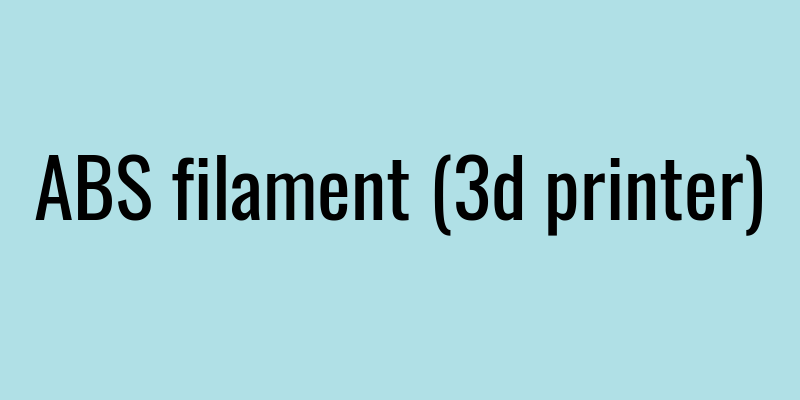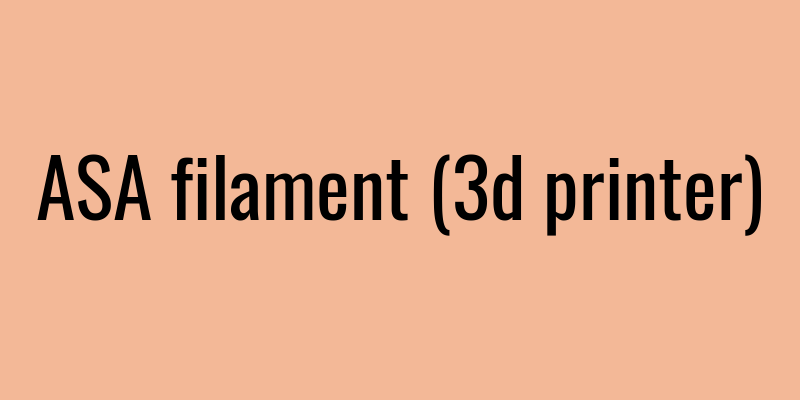The Great Debate: The Advantages and Disadvantages of ABS Filament for 3D Printing
Unlocking the Secrets of ABS Filament - Is It Right for Your 3D Printing Needs?
ABS filament, known for its strength and durability, is one of the most popular materials used in 3D printing. It has become a favorite among makers, hobbyists, and professionals alike, thanks to its versatility and range of applications. However, like any material, ABS filament comes with its own set of benefits and challenges that every 3D printer user should consider before making a choice. In this article, we will dive deep into the advantages and disadvantages of using ABS filament, allowing you to make an informed decision for your next 3D printing project.
Exploring the properties of ABS filament can drastically impact your 3D printing experience. With a melting point that enables it to withstand higher temperatures and its ability to be chemically smoothed, ABS offers unique features that can enhance the quality of your finished products. Yet, it's crucial to acknowledge that these benefits are balanced by some notable disadvantages, including production difficulties and emissions. Join us as we dissect the pros and cons of ABS filament, giving you the comprehensive insights required for successful 3D printing.
Pros
ABS filament is revered in the 3D printing community for its unique advantages. As a thermoplastic, it exhibits incredible durability and flexibility, making it suitable for a variety of applications. It is commonly used in producing everything from household items to intricate prototypes and automotive parts. But what exactly makes ABS filament stand out? In the upcoming sections, we will examine its key benefits, helping you understand why many 3D printing enthusiasts prefer it over other materials.
Unmatched Durability: The Strength of ABS Filament
One of the most significant advantages of ABS filament is its remarkable strength and resilience. ABS is known to withstand impact and handle wear and tear effectively, making it ideal for objects that require durability, such as functional prototypes or parts that will be used under stress. Unlike other filament types that may shatter or break easily, ABS maintains integrity even in demanding conditions, ensuring that your prints are not only visually appealing but also built to last.
Versatility: The Jack-of-All-Trades of Filaments
ABS filament is incredibly versatile and can be utilized in various applications across multiple industries. Whether for artistic sculptures, engineering prototypes, or intricate designs, ABS provides consistent results that cater to numerous creative needs. Furthermore, it can be easily post-processed through sanding, painting, or acetone smoothing, enabling users to achieve a superior finish. This adaptability is a key reason why many 3D printing projects opt for ABS filament.
Heat Resistance: Ideal for High-Temperature Applications
Another noteworthy advantage of ABS filament is its heat resistance. It has a higher melting point compared to other common filaments, such as PLA, making it suitable for items that will be exposed to higher temperatures. This thermal stability ensures that the printed objects do not warp or deform, providing peace of mind for those creating items meant for warm environments, like automotive components or kitchen tools.
Post-Processing Potential: A Canvas for Creativity
ABS filament offers excellent opportunities for post-processing techniques such as sanding, painting, and gluing. This makes it a favored choice among hobbyists and professionals alike who seek to enhance the aesthetics and functionality of their 3D printed objects. The ease with which ABS can be modified allows for the creation of custom products, prototypes, or artistic designs, providing designers with the flexibility they need to achieve their vision.
Good Layer Adhesion: Ensuring Strong Bonds
One of the significant advantages of ABS filament is its strong layer adhesion. When printed correctly, layers bond together cohesively, reducing the chances of delamination or splitting. This attribute makes ABS a suitable option for printing larger and more complex models that require structural integrity. The resulting parts are not only strong but also have a smooth outer finish that can significantly improve the overall look of the printed item.
Cost-Effectiveness: Affordable 3D Printing Material
ABS filament is often more cost-effective compared to other high-performance materials. Its lower price point makes it an attractive option for budget-conscious enthusiasts and businesses alike. This affordability allows for larger projects or more prints without a strict financial burden. For those who are new to 3D printing or are experimenting with prototypes, the reasonable cost of ABS can be a significant advantage, enabling users to test multiple iterations without overspending.
Post-Processing Potential: A Canvas for Creativity
One of the unique advantages of ABS filament is its excellent compatibility with various post-processing techniques. Its properties allow easy sanding, painting, and gluing, providing a blank canvas for creativity. This adaptability makes ABS an appealing choice for artists and hobbyists who wish to enhance their 3D-printed models with detailed finishes or repairs. The ability to easily modify prints opens up new avenues for design and creativity, making ABS a popular choice for custom creations.
Good Layer Adhesion: Strong Bonds Between Layers
ABS filament boasts impressive layer adhesion, leading to structurally sound prints. This strong bonding between layers helps in creating parts that can withstand stress and mechanical forces, enhancing the reliability of the final product. Good layer adhesion results in a finished item that is less prone to delamination, making it suitable for functional applications where reliability is critical, such as prototypes and end-use parts in engineering fields.
Missing a pro?
Let us know which pro you are missing!
Cons
Despite its numerous advantages, ABS filament also presents several drawbacks that are crucial for any 3D print enthusiast to consider. From challenges during the printing process to environmental concerns, these issues can significantly affect the quality and feasibility of your 3D printing projects. In this section, we'll delve into the disadvantages of ABS filament, giving you a clear understanding of what to expect when working with this material.
Printing Challenges: The Difficulties of Using ABS Filament
Printing with ABS filament can be challenging, primarily due to its tendency to warp as it cools. This warping can lead to issues with adhesion to the build plate, resulting in prints that detach during the process, which can ruin your work. Additionally, achieving optimal print settings requires experimentation and a well-calibrated 3D printer, which can be daunting for beginners. Understanding these challenges beforehand can help you better prepare for a successful print.
Fume Emissions: The Health and Safety Concerns
One significant drawback of ABS filament is its emission of fumes during the printing process, which can be hazardous when inhaled. These fumes contain volatile organic compounds (VOCs) that can lead to health issues if proper ventilation is not ensured. As a result, it is crucial to use ABS filament in a well-ventilated space or invest in filters to mitigate health risks and protect your well-being while printing.
Environmental Impact: A Sustainability Concern
Lastly, ABS filament raises environmental concerns due to its non-biodegradable nature. Unlike some biodegradable filaments, ABS will not break down naturally, contributing to plastic pollution over time. As the 3D printing community becomes increasingly conscious of sustainability, it is vital to weigh the benefits of ABS against its environmental impact and consider using alternative materials if eco-friendliness is a priority for your projects.
Warping Issues: The Challenge of Stability
Warping is a common issue when printing with ABS filament, especially on larger prints or in uncontrolled environments. As the material cools, it can shrink and pull away from the print bed, leading to a misshapen or damaged print. To counteract this, users may need to invest in higher-quality heated build plates or enclosures, which could increase the overall cost and complexity of the printing process.
Higher Cost: Budget Constraints
Compared to other commonly used filaments like PLA, ABS filament tends to be more expensive. This price difference can be a disadvantage for hobbyists or organizations on tight budgets. The higher cost may limit the amount of ABS that consumers are willing to experiment with, thereby reducing the accessibility of this material for various projects.
Warpage Issues: The Challenge of Print Accuracy
While ABS is known for its strength, one of its notable disadvantages is susceptibility to warping during the cooling process. This warping can lead to inaccuracies in complex designs and dimensions, particularly for larger prints. Users may find themselves needing to make adjustments in their design or using specific techniques like heated beds or enclosures to mitigate this issue, adding additional monitoring and workflow overhead during the printing process.
Limited Color Variety: Aesthetic Constraints
Although ABS filament is widely used, it offers a more limited range of colors compared to other materials like PLA. Designers and artists working on projects that require vibrant or unique color palettes may find this a significant constraint. The availability of fewer color options can hinder creativity in design-focused applications, necessitating additional efforts in painting or post-processing, which may not always yield the desired results.
Sensitivity to UV Light: Long-Term Durability Concern
ABS filament is sensitive to UV radiation, which can lead to color fading and degradation when exposed to sunlight over time. This drawback is particularly concerning for items intended for outdoor use or exposure to direct sunlight. Users must consider this factor in their material choice, as prolonged UV exposure could compromise the integrity and appearance of printed models, ultimately affecting their lifespan and utility.
Missing a con?
Let us know which con you are missing!
Conclusion
In conclusion, ABS filament is a powerful option in the realm of 3D printing, boasting remarkable durability, versatility, and heat resistance. However, the challenges of printing with ABS, alongside concerns about fumes and its environmental impact, should not be overlooked. By thoroughly considering both the advantages and disadvantages discussed in this article, you can make an informed decision about whether ABS filament aligns with your specific 3D printing needs. Ultimately, understanding the strengths and weaknesses of this material will help you achieve better printing results.
What do you think?
Do you think the pros outweigh the cons?





